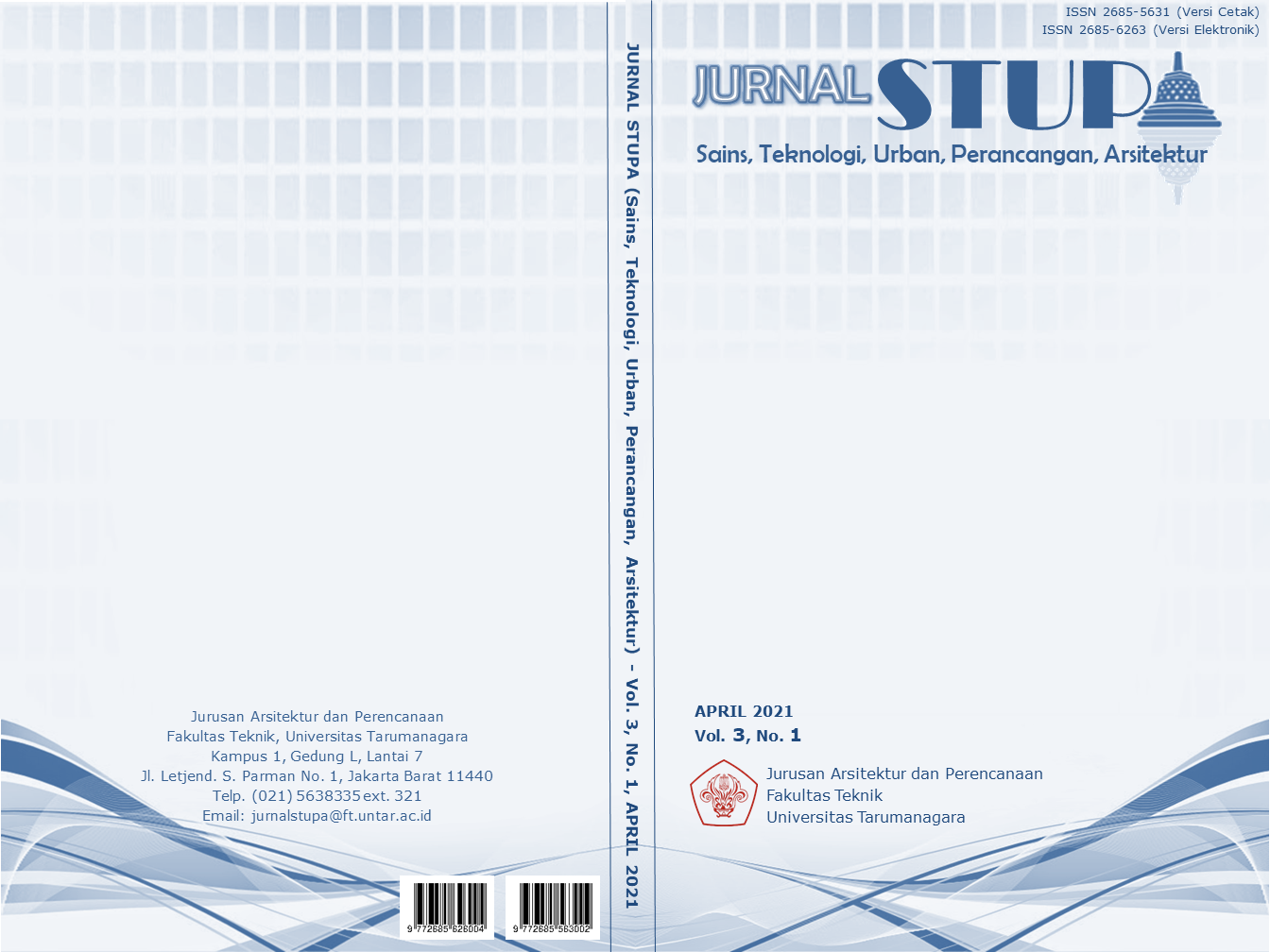PENDEKATAN NARASI ARSITEKTUR PADA WADAH KOMUNITAS ANAK JALANAN
Main Article Content
Abstract
Related to the theme of the future of living based on today, this research has a question about the problem that is the basis for today from 20 years ago to the present. This question can be related to the problem of the high rate of population growth in big cities which is not aligned with increasing social welfare, resulting in higher social inequality in society. Therefore, the term PMKS or people with social welfare problems emerged. This is of course related to words such as marginal, vulnerable, and exploitative, which are very appropriate terms to describe the conditions of the life of PMKS. In this case, most PMKS are based on the age point of 6-18 years according to data from the RI social welfare which is classified as street children. Outcast are children who are psychologically helpless, children who at some level do not have enough mentally and emotionally strong, while they have to deal with harsh street life and tend to have a negative effect on the development of their behavior and the formation of their personality coupled with a family background that has economic problems. Their existence is often seen and disturbs people in big cities in Indonesia. one of them is in the city of DKI Jakarta. In essence, all living things need a place to take shelter where they get protection from various threats, but they also feel safe and comfortable in a place (space). Is it possible that spaces with activities that encourage outcast to be independent will be formed so that they can reduce the social problems of outcast that exist today to create an independent dwell for them in the future?
Keywords: dwelling; outcast; social welfare.
Abstrak
Terkait dengan tema soal masa depan berhuni berbasis hari ini, penelitian ini mempunyai pertanyaan akan masalah yang menjadi dasar sampai hari ini dari jangkauan waktu 20 tahun silam sampai dengan saat ini. Pertanyaan terebut dapat dikaitkan dengan masalah pada tingginya tingkat pertumbuhan penduduk di kota-kota besar yang tidak diselaraskan dengan meningkatnya kesejahteraan sosial, mengakibatkan semakin tingginya ketimpangan sosial yang terjadi di masyarakat. Maka dari itu muncul istilah PMKS atau penyandang masalah kesejahteraan sosial. Hal ini tentunya berkaitan dengan kata-kata seperti marginal, rentan, dan eksploitatif yang merupakan istilah yang sangat tepat untuk menggambarkan kondisi dari kehidupan PMKS. Dalam hal ini PMKS terbanyak berdasarkan segi usia 6-18 tahun menurut data dari kesejahteraan sosial RI yang tergolong sebagai anak jalanan. Anak jalanan adalah anak yang tidak berdaya secara psikologis, anak yang pada suatu taraf tertentu belum memiliki cukup mental dan emosional yang kuat, sementara mereka harus bergelut dengan kehidupan jalanan yang keras dan cenderung berpengaruh negatif bagi perkembangan prilaku dan pembentukan kepribadian mereka. ditambah lagi dengan latar belakang keluarga yang mempunyai masalah-masalah ekonomi. Keberadaan mereka sering terlihat dan menganggu masyarakat di kota-kota besar di Indonesia. salah satu nya di kota DKI Jakarta. Pada Hakikatnya semua makhluk hidup memerlukan wadah untuk bernaung dimana mereka mendapatkan perlindungan dari berbagai ancaman, namun mereka juga merasakan aman dan nyaman pada sebuah tempat (space). Mungkinkah ruang-ruang dengan aktivitas yang mendorong anak jalanan untuk mandiri akan terbentuk sehingga dapat meredahkan permasalahan sosial anak jalanan yang ada saat ini untuk terciptanya sebuah dwell yang mandiri untuk mereka di masa depan?
Article Details
References
Dorothy, L. (1954). The Classic Poem "Children Learn What They Live". https://counselwise.ca/children-learn-what-they-live-classic/
Heidegger, M. (1971). Building Dwelling Thinking. From Poetry, Language, Thought, translated by Albert Hofstadter. New York: Harper Colophon Books. http://home.lu.lv/~ruben/Building%20Dwelling%20Thinking.htm
Huraerah, A. (2018). Kekerasan Terhadap Anak. Jakarta: Penerbit Nuansa.
Kalida. (2005). Sahabatku Anak Jalanan. Yogyakarta: Alief Press.
Frinaldi, A. , dkk. (2011). Kebijakan Penanggulangan dan Pembinaan Anak Jalanan di Kota Padang. Laporan Penelitian. Padang: Universitas Negeri Padang. http://repository.unp.ac.id/383/1/ALDRI%20FRINALDI_145_13.pdf
Salura, P. (2010). Arsitektur Yang Membodohkan. In P. (.Salura). CSS Publishing. Retrieved from https://scholar.google.co.id/scholar?cluster=11407703609643733448&hl=id&as_sdt=2005& sciodt=0,5
Schulz, C. N. (1985). The concept of dwelling : on the way to figurative architecture. In C. Norberg-Schulz. Retrieved from https://www.worldcat.org/title/concept-of-dwelling-on-the-way-to-figurative-architecture/oclc/11814032
Suyanto, B. (2010). Masalah Sosial Anak. Jakarta: PT. Gramedia Pustaka Utama
Trisno, R., & Lianto, F. (2018). Relationship Between Function-Form in The Expression of Architectural Creation.
Trisno, R., Wibisono, A., Lianto, F., & Sularko, V. (2020). Translation of Narratology Model in Literature into Narrative Museum Architecture. Advances in Social Science, Education and Humanities Research,, 1141-1146. Retrieved from http://creativecommons.org/licenses/by-nc/4.0/.
Wibisono, A., Trisno, R., & Lianto, F. (2020). Analysis of Design Paradigms based on Technology Features at GaleriIndonesia Kaya. IOP Conf. Series: Materials Science and Engineeri, 1-5. doi:doi:10.1088/1757-899X/1007/1/01200



